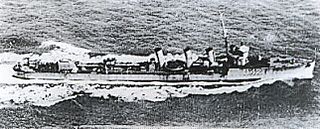Three ships and one shore establishment of the Royal Navy have borne the name HMS Osiris, after the Egyptian god Osiris:

The Royal Navy (RN) is the United Kingdom's naval warfare force. Although warships were used by the English kings from the early medieval period, the first major maritime engagements were fought in the Hundred Years War against the Kingdom of France. The modern Royal Navy traces its origins to the early 16th century; the oldest of the UK's armed services, it is known as the Senior Service.

Egyptian mythology is the collection of myths from ancient Egypt, which describe the actions of the Egyptian gods as a means of understanding the world around them. The beliefs that these myths express are an important part of ancient Egyptian religion. Myths appear frequently in Egyptian writings and art, particularly in short stories and in religious material such as hymns, ritual texts, funerary texts, and temple decoration. These sources rarely contain a complete account of a myth and often describe only brief fragments.

Osiris is the god of the afterlife, the underworld, and rebirth in ancient Egyptian religion. He was classically depicted as a green-skinned deity with a pharaoh's beard, partially mummy-wrapped at the legs, wearing a distinctive atef crown, and holding a symbolic crook and flail. Osiris was at times considered the eldest son of the god Geb and the sky goddess Nut, as well as being brother and husband of Isis, with Horus being considered his posthumously begotten son. He was also associated with the epithet Khenti-Amentiu, meaning "Foremost of the Westerners", a reference to his kingship in the land of the dead. As ruler of the dead, Osiris was also sometimes called "king of the living": ancient Egyptians considered the blessed dead "the living ones". Through syncretism with Iah, he is also the god of the Moon.
- HMS Osiris (1916) was an Admiralty M-class destroyer launched in 1916 and sold in 1921.
- HMS Osiris (N67) was an Odin-class submarine launched in 1928 and sold in 1946, being broken up in 1952.
- HMS Osiris (S13) was an Oberon-class submarine launched in 1962 and sold to Canada in 1992, where she was dismantled for spare parts and broken up that year.
- HMS Osiris (shore establishment) was a shore establishment in Egypt in the late 1940s/early 1950s.

The M class, more properly known as the Admiralty M class, were a class of 85 destroyers built for the Royal Navy that saw service during World War I. All ships were built to an identical - Admiralty - design, hence the class name. 18 other vessels which were officially included within the 'M' class were built to variant designs by three specialist builders - 10 by Yarrow, 6 by Thornycroft, and 2 by Hawthorn Leslie; however, these are listed in other articles.

In naval terminology, a destroyer is a fast, maneuverable long-endurance warship intended to escort larger vessels in a fleet, convoy or battle group and defend them against smaller powerful short-range attackers. They were originally developed in the late 19th century by Fernando Villaamil for the Spanish Navy as a defense against torpedo boats, and by the time of the Russo-Japanese War in 1904, these "torpedo boat destroyers" (TBDs) were "large, swift, and powerfully armed torpedo boats designed to destroy other torpedo boats". Although the term "destroyer" had been used interchangeably with "TBD" and "torpedo boat destroyer" by navies since 1892, the term "torpedo boat destroyer" had been generally shortened to simply "destroyer" by nearly all navies by the First World War.

HMS Osiris was an O-class submarine of the Royal Navy. She was laid down by Vickers-Armstrongs of Barrow-in-Furness on 12 May 1927, launched on 19 May 1928 and commissioned on 25 Jan 1929.
| This article includes a list of ships with the same or similar names. If an internal link for a specific ship led you here, you may wish to change the link to point directly to the intended ship article, if one exists. |
